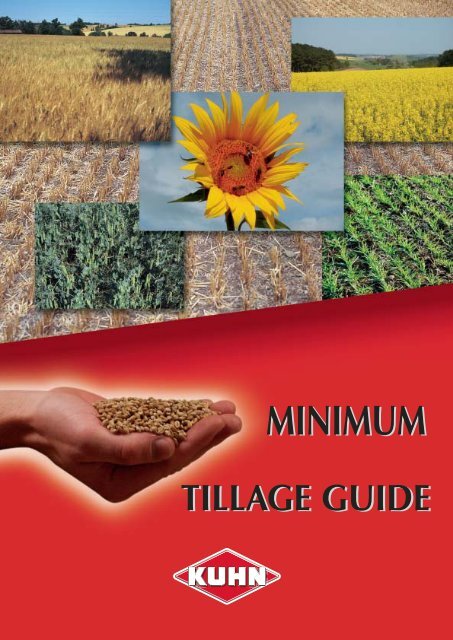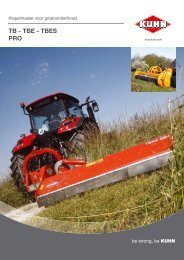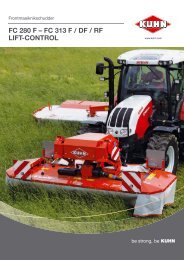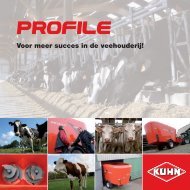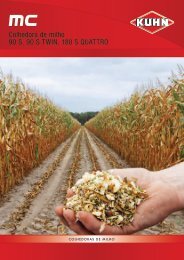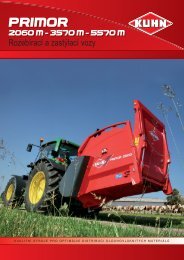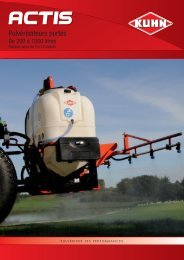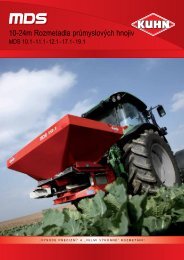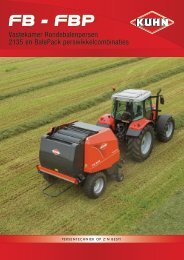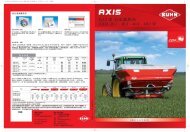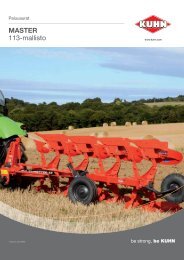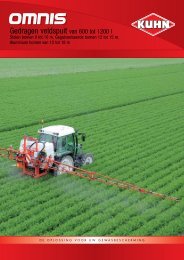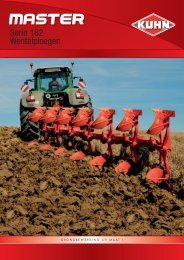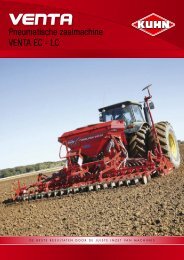Minimum tillage or direct drilling
Minimum tillage or direct drilling
Minimum tillage or direct drilling
- No tags were found...
Create successful ePaper yourself
Turn your PDF publications into a flip-book with our unique Google optimized e-Paper software.
MINIMUMTILLAGE GUIDE
Summary• Kuhn : a minimum <strong>tillage</strong> specialist.• <strong>Minimum</strong> <strong>tillage</strong> techniques viewed by two specialists.• European agriculture in development.• Analysis of wheat production costs.• Economic and <strong>or</strong>ganisational implications.• The effect of minimum <strong>tillage</strong> on plant development.• Agronomic implications.• Environmental implications.• Success fact<strong>or</strong>s.• The Kuhn Concept : Non-PTO driven implements.• Inter-crop management : Choosing your implements.• Inter-crop management : Choice of Non-PTO driven implements.• Seeding f<strong>or</strong> success.• <strong>Minimum</strong> <strong>tillage</strong> <strong>or</strong> <strong>direct</strong> <strong>drilling</strong>.• Alternative PTO driven solutions f<strong>or</strong> minimum <strong>tillage</strong>.• Essential f<strong>or</strong> residue management.• Bibliography and acknowledgements34 - 67 - 89 - 1112 - 1314 - 1516 - 171819 - 2122 - 2526 - 2728 - 3031 - 3233 - 36373839
KUHN : A MINIMUM TILLAGE SPECIALISTChanges in the economic and regulat<strong>or</strong>y environment are f<strong>or</strong>cing farmers to review theirproduction systems by using minimum <strong>tillage</strong> techniques.When fully implemented a minimum <strong>tillage</strong> system will enable producers to:-reduce the cost of production e.g. machinery and labour-rethink crop production systems e.g. retaining crop residues on the soil surface, improvingbiological activity-make environmental improvements e.g. reduce erosion, and loss of nutrientsThe area of land non-ploughed w<strong>or</strong>ldwide has increased fourfold in the lastten years. In Europe it is estimated that 25% of the cultivated area is nolonger ploughed. There is a diverse range of options available from <strong>direct</strong><strong>drilling</strong> into a cover crop to deep cultivations, which have the same versatilityas ploughing. This would suggest that equipment adaptable f<strong>or</strong> use ina variety of systems is required.In this guide the Kuhn group outlines the various <strong>tillage</strong> systems availableto farmers and makes suggestions on which Kuhn equipment is bestadapted to which system. It must be emphasized that non-plough systemsrequire changes in crop agronomy such as residue management, fertiliserpolicy and crop protection programmes.To be successful, this approach needs to be viewed as a complete system.3
<strong>Minimum</strong> <strong>tillage</strong> techniquSteve Townsend, Steve Townsend & Company,Economic Crop Systems Specialists, United Kingdom<strong>Minimum</strong> <strong>tillage</strong> systems are now an establishedpart of mainstream UK agriculture,accounting f<strong>or</strong> an estimated 40% of allcultivations, but as across Western Europe as a whole,it is a concept still in its infancy when compared withactivities in N<strong>or</strong>th America, Latin America, andAustralia, f<strong>or</strong> example.A false start in the 1970’s and 80’s, together with anagricultural supp<strong>or</strong>t regime that encouraged complacencyahead of innovation, are jointly responsible f<strong>or</strong>our own relatively slow uptake of minimum <strong>tillage</strong>, butwe are now entering an era where better knowledgeand superi<strong>or</strong> drill technology are underpinningsustained growth.With stronger financial imperatives now driving farmer> Steve Townsenddecision making under the Single Farm Payment, andimproved soil management at the heart of cross compliance requirements, there is every reason to expectan acceleration in the uptake of minimum <strong>tillage</strong> in the future.Early adopters of minimum <strong>tillage</strong> systems in the 1970’s and 80's were hampered by under-developedequipment often unsuitable f<strong>or</strong> the UK's temperate climate. There was also little understanding of staleseedbeds at that time, and the cost of glyphosate was prohibitively high.The ban on straw burning in 1992, which at the time seemed to signal the death knell f<strong>or</strong> minimum<strong>tillage</strong> systems, has ironically triggered a revival that has led us to the position we are in now. Followingthe ban, a greater focus on straw inc<strong>or</strong>p<strong>or</strong>ation accelerated our understanding of soil structure and theimp<strong>or</strong>tance of increasing <strong>or</strong>ganic matter levels. These issues lie at the heart of the minimum <strong>tillage</strong>concept and are the reason that established systems succeed.UK farmers exemplify the full spectrum of minimum <strong>tillage</strong> systems. Very few are exclusively usingminimum <strong>tillage</strong>, and very few will now plough everything, and within this mix of usage is a range ofactivity from several-stage cultivation through to <strong>direct</strong> <strong>drilling</strong>. In each case, the primary incentive f<strong>or</strong>the farmer is to reduce crop establishment costs, and in my experience a 40% saving should be achievable,and up to 60% is possible.4Beyond the reduction in establishment costs, an effective minimum <strong>tillage</strong> system will, through theimprovements to soil structure and fertility, also lead to reduced variable costs and m<strong>or</strong>e consistent yields.Fertiliser inputs, f<strong>or</strong> example, can typically be expected to fall by 20-30% once a system is fully established.
es viewed by two specialistsWith soil management central to farmers' cross compliance obligations, the improved structure thatincreased <strong>or</strong>ganic matter levels bring provides an added incentive f<strong>or</strong> minimum <strong>tillage</strong>. Soil erosionbecomes less of a problem, and the risks of phosphate and nitrate leaching are reduced under effectiveminimum <strong>tillage</strong> systems. There are many different minimum <strong>tillage</strong> systems operating in the UK, andfarmers will continue to range from the opp<strong>or</strong>tunists to the fully committed, but there is in my mind nodoubt that uptake can only increase. We now have the technology and the knowledge, so with a continuingincrease in the desire to make it w<strong>or</strong>k I see no reason why the prop<strong>or</strong>tion of UK cultivations inminimum <strong>tillage</strong> should not in time increase to 80% plus.Prof. Dr. K. Köller < Universität Hohenheim, GermanyThere is a strong need f<strong>or</strong> a global transition from conventionalto conservational farming methods due to :• The dramatic global increase in soil destructionthrough soil erosion and the accumulation of salts.• The increasing destruction of the humus layer due tointensive cultivation.• The associated increase in carbon dioxide emissions aswell as decreasing biodiversity due to the consistentremoval of plant material from the ground.> Prof. Dr K. KöllerThe contribution of “Conservation Agriculture” to ensuresustainable w<strong>or</strong>ld-wide nutrition, the fight against poverty and the conservation of sustainable resourcesis repeatedly emphasized, and has been widely outlined in extensive literary sources. The difficultiesare generally recognised, but in this area there are essentially implementation problems.The consequences of soil erosion do not only concern regions of the southern hemisphere. In Europe,conventional farming methods marked by the removal of vegetation following harvesting and intensivecultivation, result in negative effects on the quality of the soil, water and air, the global climate as wellas biodiversity and the countryside.Around 150 million hectares of farmland in Europe are affected by erosion. The average annual erosionrate amounts to 17 tons per hectare/year and lies far above the rate of soil f<strong>or</strong>mation at around 1 ton perannually. It is believed that through soil erosion, agricultural production costs in Europe will increase by50 EUR per hectare per year. Taking the on- and off-site damage into account, the total costs of soilerosion are estimated at around 85 EUR per hectare of arable land in production.As a result of conventional farming methods, regional water quality is declining along with biodiversity. Farmconservation methods enable the disadvantages outlined to be permanently avoided. Soil erosion, as well asthe impairment of water quality from the application of manure, plant protection agents and CO2 emissions,will be significantly reduced and the biological activity of the soil and biodiversity markedly improved.5
<strong>Minimum</strong> <strong>tillage</strong> techniques viewed by two specialistsAt the heart of conservation agriculture is permanentground cover through vegetation and plant debris,and thus a preference towards non-plough soil preparationtechniques and diversified crop rotations.Conservation agriculture does not mean “OrganicFarming”, as it can include the use of artificial fertilisersand plant protection agents; another goal ofconservation agriculture is the sustainability of ourfood supply through increased yields.> Prof. Dr K. KöllerIn the long run conservation agriculture does not mean anything different from the implementation ofminimum <strong>tillage</strong> <strong>or</strong> <strong>direct</strong> seeding, integrated into an area specific management system, where appropriatemeasures of crop rotation <strong>or</strong>ganisation and use of fertilisers and plant protection agents are considered.These practices are m<strong>or</strong>e widely found in large areas of N<strong>or</strong>th and South America than in Europebecause the soil erosion and economic pressures leave the farmers with no other choice. Whilst theenvironmental and economic advantages are evident and proven f<strong>or</strong> European conditions, methods ofconserving agriculture are unf<strong>or</strong>tunately not employed nearly enough, but here also the economic andenvironmental constraints will significantly increase in the near future. It can only be hoped thatthrough political and administration supp<strong>or</strong>t, these technologies will experience increasing acceptancefrom farmers.Conservation agriculture is m<strong>or</strong>e than a special means of land management that only serves farmers. It isapplicable f<strong>or</strong> the whole of society. Theref<strong>or</strong>e politicians, international <strong>or</strong>ganisations, environmentalists,farmers, industries, science and research as well as training programmes and conferences, will use conservationagriculture as a basis to understand and develop a lasting life insurance f<strong>or</strong> future generations.The recommendation f<strong>or</strong> European farmers can only be to move towards minimum <strong>tillage</strong> and <strong>direct</strong> seedingsystems. F<strong>or</strong> many this means a change in habits but there is no other serious alternative. Economicand environmental advantages are convincing. Agricultural entrepreneurs are sought after.Inside the KUHN <strong>Minimum</strong> Tillage Guide you will find :• Practical inf<strong>or</strong>mation on the transition to conservation cultivation and shredding.• Detailed technical inf<strong>or</strong>mation.• Answers to your field and plant structural questions.• An insight into labour <strong>or</strong>ganisation and economic and environmental considerations.6
European Agriculture in DevelopementDuring the modern era of farm supp<strong>or</strong>t, the financial output of arable crops has been thesum of the commodity price plus area aid. CAP Ref<strong>or</strong>m, however, has brought a change inthe payment regime and a reduction in the overall level of supp<strong>or</strong>t. Farmers are now requiredto fulfil certain criteria in <strong>or</strong>der to qualify f<strong>or</strong> different f<strong>or</strong>ms of supp<strong>or</strong>t payments.“AID TO EUROPEAN FARMS AND THEIR METHOD OF DISTRIBUTION”Aid to farmers is fundamental. It accounts f<strong>or</strong> 69% of farm profit in the combinable crop sect<strong>or</strong> and 53%in the mixed livestock sect<strong>or</strong>. The survival of European agriculture is dependant upon a satisfact<strong>or</strong>y levelof aid.To conf<strong>or</strong>m to the WTO, farm aid has had to be re-<strong>direct</strong>ed from production. Aid is now payable on anarea basis independent of what is being produced on the land. The EU has set out the general framew<strong>or</strong>kand with national governments deciding how payments are made in their countries.Certain criteria have been, <strong>or</strong> have to be adopted by each member state. F<strong>or</strong> instance, a reference period(2000-2002) determines who is entitled to claim f<strong>or</strong> aid. The exact crops and stock that can be claimedf<strong>or</strong> during that period varies from country to country.To be eligible to claim payments in future, it will be necessary in all countries f<strong>or</strong> individual farmers tocarry out cross-compliance. Again, this is interpreted differently in almost every state. Broadly speaking,producers must abide by certain animal welfare guidelines and in the case of arable cropping (with referenceto this publication) the EU water framew<strong>or</strong>k <strong>direct</strong>ives. The main aim is to reduce soil erosion andin turn the offsite pollution that can occur.In addition to cross-compliance, environmental schemes will enable farmers to claim extra payments bydoing a little bit m<strong>or</strong>e in the way of “greening-up”. This money will come from modulation of the mainpayment (starting at 3% in 2005 and going up to 5% by 2007 – with an exemption of those claiming lessthan €5000) by the EU.The individual member states will also be able to modulate the payments (by up to 30%) f<strong>or</strong> rural developmentschemes. These schemes can vary from payments f<strong>or</strong> agricultural infrastructure through to aidf<strong>or</strong> young farmers. These payments are determined on a national basis and do not necessarily have to gointo agriculture.7
European agriculture in development“ WHAT IS THE FUTURE FOR EUROPEAN CEREAL PRODUCTION? ”>> THE THREAT OF COMPETITION FROM OUTSIDE EUROPEWheat production costs in some countries can be m<strong>or</strong>e than double that of others (See graph 1). In theW<strong>or</strong>ld market the position of European wheat is extremely fragile. Furtherm<strong>or</strong>e, when production in theEastern European countries begins to take off, it will be difficult f<strong>or</strong> European wheat to remain competitive.The cost of producing Ukrainian wheat is on average 20% less than that of Europe, due to lowerinput and labour costs. It is necessary to cut the cost of production in Western Europe if we are to remaincompetitive. However, consistency in terms of quantity and quality is still in our favour.Graph 1 : Production costs of the 5 main wheat exp<strong>or</strong>ting countries (2000)Cost of production €/tonArgentina Australia Canada Europe USA Ukraine*Land costs (including rent)Other fixed costsLabour costsMachinery costsVariable costs (e.g. seed,fertilisers, sprays.)1€ = 1.09 US$= 1.09 peso= 1.64 CA$= 1.53 AU$Source:Arvalis Institut du Végétal*Estimated valueExchange rates have a heavy influence on production costs in different countries, however countries suchas Argentina, Australia and Ukraine are able to produce wheat at a lower cost than areas with higher costssuch as Europe, USA and Canada.>> WAYS TO IMPROVEEuropean wheat producers have cut their production costs through firm control of inputs, but also in thearea of labour and machinery where perhaps most savings can be made.Table 1: Variation in the cost of winter cereal production in 5 countries.€ €€ €€€ €€€€Inputs USA Argentina, Australia, Canada EuropeEquipment Australia Canada, USA Europe ArgentinaLabour Argentina Australia, Canada Europe, USAExternal Services Canada Australia, Argentina USALand Europe Argentina Canada, Australia USA8Source: Arvalis-Institut du Végétal, 2002.
Analysis of wheat production costsWith uncertain economic returns and market globalisation, European farmers are looking atways to cut the cost of wheat production in <strong>or</strong>der to remain competitive.“ BREAKDOWN OF PRODUCTION COSTS ”Figure 1 : Details of the cost structure of wheat production.GROSS PROFITProp<strong>or</strong>tional CostsFixed Costs72%28%11%15%46%RENTGENERAL FARM EXPENSESLABOUR ANDMACHINERYAGRICULTURAL REVENUESource : Arvalis-institut du végétal-CNCER-UNIGRAINS, 2002>> VARIABLE COSTS (e.g. SEEDS, SPRAYS, FERTILISERS)Management determines the unit cost of production. A spray programme based on insurance sprayapplications can cost as much as 30% m<strong>or</strong>e than a programme based on applying what is required f<strong>or</strong>each field. However there comes a point where inputs can not be cut any further without reducing cropyields.>> FIXED COSTS :AN IMPORTANT AREA FOR COST REDUCTIONLabour and machinery costs account f<strong>or</strong> 65% of fixed costs <strong>or</strong> 46% of the total cost of production. It isimp<strong>or</strong>tant to link labour and machinery as in general, when labour is reduced it is replaced bymachinery. Obtaining the right balance will contribute to wheat production remaining competitive inWestern Europe.9
Analysis of wheat production costs.“REDUCING LABOUR AND MACHINERY COSTS”Reducing capital investment and the time used to carry out field operations are the two areas where labourand machinery costs can be reduced.>> LOWERING THE CAPITAL INVESTED PER HECTARE2 possible solutions :• Reduce investment in equipment : There is an element of risk involved in considering thisroute. The higher the investment in machinery, the higher the return on investment must be.• Spread investment over a larger area : Increasing the area w<strong>or</strong>ked reduces the unit cost perhectare of machinery and labour.>> REDUCING WORK TIMEAs labour costs represent 20% of production costs, farmers need to cover the largest possible area withthe minimum of labour. To do this requires suitable equipment and a satisfact<strong>or</strong>y balance between the areafarmed and available labour.10
“ MANAGING THE INTER-CROP PERIOD, SOIL PREPARATIONAND SEEDING ”Figure 2 : Breakdown of labour and machinery costs involved in wheat production.MACHINERY AND LABOUR19%14%TRANSPORT - IRRIGATIONSPRAYING AND FERTILISER APPLICATION22%45%HARVESTSOIL PREPARATION ANDSEEDINGAREAS WHERE COSTREDUCTIONS AREPOSSIBLE>> CULTIVATION COSTS REPRESENT45% OF MACHINERY AND LABOUR COSTS !Cultivation costs account f<strong>or</strong> approximately 45% of the labour and machinery costs. The exact level willdepend on the type of cropping used. Farms producing industrial crops (e.g. sugar beet, potatoes) andthose with livestock will have higher costs than those producing solely combinable crops. Reviewing theoverall system can have an imp<strong>or</strong>tant influence on cost reduction.>> SHOULD PLOUGHING BE ELIMINATED ?Systems in which the plough is used less can lead to reduced investment in equipment. Such systems areoften less labour intensive, thus resulting in reduced labour and machinery costs. Agronomicallyspeaking, it is now possible, it makes economic sense (reducing production costs) and concurs with thelatest European <strong>direct</strong>ives (conditions required to receive EU payments).11
Economic and <strong>or</strong>ganis<strong>Minimum</strong> <strong>tillage</strong> reduces the number of tract<strong>or</strong> hours required per hectare and in turnthe amount of labour required. This results in cost savings f<strong>or</strong> the business.“ ORGANISATIONAL IMPLICATIONS ”>> TIME SAVINGThe amount of time saved by adopting a non-plough system depends on how much cultivations can bereduced and the type of machinery used. By adapting existing machinery, savings in tract<strong>or</strong> hours rarelyexceed 15-20%. However, by using specialist implements, savings of 40% can be achieved by simplymoving less soil. The average plough based system takes 2.6 hours/ha to establish a crop whereas aminimum <strong>tillage</strong> based system would take about 1.3 hours /ha and <strong>direct</strong> <strong>drilling</strong> just half an hour.It is imp<strong>or</strong>tant to understand how the <strong>tillage</strong> w<strong>or</strong>k schedule is broken down so that areas requiringre-structuring can be addressed. To illustrate this concept, the following example shows the estimatedamount of time that would be spent cultivating an average 200ha clay-chalk farm growing combinablecrops (rotation of oilseed rape, wheat, barley) using three different systems.Table 2 : Time needed f<strong>or</strong> different cultivation practicesPlough based system Time/ha Reduced <strong>tillage</strong>1 x 5 furrow plough,6km/hr, 0.9ha/hr1 x 4m stubble tine cultivat<strong>or</strong> ,5km/hr, 1.4ha/hr1 <strong>drilling</strong> pass (4m powerharrow/drill combination),5km/hr, 1.4ha/hrTime spent in the fieldTotal time spent includingtravelling1.10.350.72.152.62 x 4m stubble tine cultivat<strong>or</strong>,10km/hr, 2.5ha/hr1 <strong>drilling</strong> pass (3m specialistdrill), 12km/hr, 2.5ha/hrTime spent in the fieldTotal time spent includingtravellingTime/ha0.70.41.11.3Direct <strong>drilling</strong>3m Direct drill,12km/hr, 2.5ha/hrTime spent in thefieldTotal time spentincluding travellingTime/ha0.40.40.5>> MAKING BETTER USE OF WEATHER WINDOWSWeather conditions often only allow a brief period in which to complete crop establishment. It is necessaryto adopt a system which makes best use of these conditions and allows f<strong>or</strong> timely sowing of allvarieties (delaying <strong>drilling</strong> by 15 days can reduce wheat yields by 0.1 ton per ha). Where minimum <strong>tillage</strong>is adopted, although the weather windows may be sh<strong>or</strong>ter, output is greater, thus making better use ofthe available time. Picking the right time and acting quickly is imp<strong>or</strong>tant.12• TIME>> EASIER ORGANISATION• TIME SPENT ON OTHER ACTIVITIES (e.g. management, special cropping, livestock.…)Time saved by changing to minimum <strong>tillage</strong> can be of value to other enterprises. A farmer, growing120 ha of arable crops, would need to do 850 tract<strong>or</strong> hours per year (7hr/ha using a conventional system).If he changed to a <strong>direct</strong> <strong>drilling</strong> system, he would save 2 hours per hectare, giving an overall saving of240 hours.• LABOUR• LABOUR FLEXIBILITYSome businesses have potential labour sh<strong>or</strong>tages when they expand of if a partner pulls out of thebusiness. In this situation minimum <strong>tillage</strong> makes the best use of existing labour resources.
ational implications• FUEL“ ECONOMIC PERFORMANCE : LONG TERM ARGUMENTS ”>> SOME UNQUESTIONABLE BENEFITS• FUEL CONSUMPTION AS A KEY PERFORMANCE INDICATORReducing the number of tract<strong>or</strong> hours/ha obviously reduces overall fuel consumption. This will benoticed by the farmer during the first year after changing his system.Fuel consumption is estimated to be 100 litres/ha when a plough based system is operated. This can bereduced to approximately 75 litres/ha when ploughing ceases. When <strong>direct</strong> <strong>drilling</strong>, fuel consumptionof 65 litres/ha could be expected, a 35% reduction from a plough based system. Furtherm<strong>or</strong>e, by w<strong>or</strong>kingless hours, tract<strong>or</strong>s need to be replaced less often. Fuel savings are also dependent on soil type, f<strong>or</strong>example, higher saving will be made on clay soil than sand.• LONG TERM BENEFITSWhen converting to a minimum <strong>tillage</strong> system, there is a danger that machinery costs may rise in thesh<strong>or</strong>t term. However, in the long term, wearing parts and maintenance costs will be much lower thanwhere a plough based system was used. Furtherm<strong>or</strong>e, the equipment used will not depreciate so fast, thusimproving its re-sale value.>> BENEFITS OF SHARING LABOUR AND MACHINERYIncreasing the area w<strong>or</strong>ked reduces production costs. This reduction in unit costs can be achieved in anumber of ways : by co-operating with neighbours, joining a machinery ring, <strong>or</strong> by contracting. Whenproperly managed, such a ‘co-operation’ can reduce labour and machinery costs by as much as 40-45%.This would represent 20% of the total production costs. <strong>Minimum</strong> <strong>tillage</strong> accounts f<strong>or</strong> a 19% share ofthese costs and labour in the <strong>or</strong>der of 10%. The remaining 24% is accounted f<strong>or</strong> in reduced capital investmentand being able to re-deploy labour to jobs other than soil cultivation.Figure 3 : Possibilities f<strong>or</strong> reducing labour and machineryLABOUR ANDMACHINERY57%24%19%OTHER MACHINERY COSTSSOIL CULTIVATIONREDUCTIONSIMPOSSIBLEREDUCTIONSFORESEENThese benefits depend very much on the type of minimum <strong>tillage</strong> system adopted, the soil type and thecropping system.13
The effect of minimum tillThe impact of minimum <strong>tillage</strong> on plant development depends on the system used.(deep cultivation <strong>or</strong> <strong>direct</strong> <strong>drilling</strong> into a cover crop)“ GERMINATION AND EARLY ESTABLISHMENT ”The condition of the land (soil structure) has a strong influence on the final crop yield. This is especiallytrue f<strong>or</strong> crops requiring a good root structure (e.g. maize and sugar beet) and those with a sh<strong>or</strong>t growingperiod (e.g. spring sown crops)>> MOISTURE FOR GERMINATIONThe abs<strong>or</strong>ption of water by the seed is dependent on the moisture surrounding the seed and the seed tosoil contact. Non-inversion <strong>tillage</strong> retains a layer of mulch on the soil surface which retains soil moistureand thus reduces evap<strong>or</strong>ation. <strong>Minimum</strong> <strong>tillage</strong> reduces clod f<strong>or</strong>mation especially in clay soils, and thecontinuous soil structure favours the re-distribution of water by capillary action. These conditions improveseed germination, notably f<strong>or</strong> crops drilled under dry conditions such as oilseed rape.>> AERATION FOR SEEDLING RESPIRATIONAir is necessary f<strong>or</strong> seed germination and establishment. The f<strong>or</strong>mation of surface crusting in silty soilsand clods in clay soils reduces gaseous exchange. Where non-inversion <strong>tillage</strong> is used, the presence of<strong>or</strong>ganic material on the soils surface reduces capping. The lack of deep cultivation reduces the f<strong>or</strong>mationof clods and the possible mechanical limitation to early root growth is reduced.>> TEMPERATUREF<strong>or</strong> initial germination, a certain level of accumulated temperature, <strong>direct</strong>ly relating to the p<strong>or</strong>osity andmoisture content of the soil, is required. A free draining soil warms up faster than a compact waterloggedsoil. The presence of surface mulch slows down soil warming. This explains why spring crops germinatelater. The mineralization of soil nutrients available to the plants are reduced in colder soils. F<strong>or</strong> this reason,the fertiliser programme needs to be modified. However, later in the season the nutrients are releasedand this explains how min-till crops compensate f<strong>or</strong> their slow early establishment.Figure 4 : The ideal seedbed.TemperatureGaseous exchangeOrganic matterSeedbed14MoistureSettled lower soillayers allowing f<strong>or</strong>water re-distributionby capillary action.
age on plant development“ GROWTH AND DEVELOPMENT ”When the seed’s nutrient reserves are exhausted, the soil has to then supply nutrients via the roots. Plantdevelopment c<strong>or</strong>responds to root size and the availability of nutrients, oxygen and water in the soil. Thedevelopment of the aerial parts of the plant are governed by photosynthesis.>> ROOT DEVELOPMENTThe development of the root system depends upon mechanical resistance determined by differing layersin the soil structure. A consistent and p<strong>or</strong>ous soil structure, developed in a non-inversion <strong>tillage</strong> system,allows f<strong>or</strong> good root expl<strong>or</strong>ation. With the absence of deep cultivation, soils tend to become firmer andf<strong>or</strong>m a new m<strong>or</strong>e natural structure. The structure is supp<strong>or</strong>ted by cracking and galleries are f<strong>or</strong>med bydecaying roots and earthw<strong>or</strong>m burrows. The new structure is m<strong>or</strong>e efficient than a man-made structurecreated by excessive cultivations.>> PLANT NUTRITIONThe reserve of soil nutrients depends on <strong>or</strong>ganic matter levels, the amount of fertilizer applied and thesoil’s ability to retain fertility. By adopting non-inversion <strong>tillage</strong>, <strong>or</strong>ganic matter level in the upper layersof the soil profile increases and in time soil fertility is improved. These fundamental changes to the soilwill have an effect on plant development. As the <strong>or</strong>ganic matter mineralises, the plant roots caneasily abs<strong>or</strong>b the nutrients released.>> PLANT HEALTHThe presence of the residue on the soil surface from the previous crop creates the ideal environment f<strong>or</strong>the development of pests and diseases f<strong>or</strong> the emerging crop. However with good crop rotation, a judiciouschoice of varieties, effective stubble cultivation and an appropriate use of crop protection products, the riskof pests and diseases developing is reduced.Figure 5 : Processes in plant nutrition.PrimarymineralisationFixation on clay-humuscomplexHumificationHumusSecondarymineralisationLeachingBreakdown of‘ bed rock’by rootsK+ ions move into the soilsolution to f<strong>or</strong>m equilibriumReserves st<strong>or</strong>ed in clayhumuscomplexSome of the Ca2+ ions become fixed to thecomplex to compensate f<strong>or</strong> the loss of the K+ ions15
Agronomic iChanging from a plough based system will have an impact on <strong>or</strong>ganic matter distribution,the soil’s processes and the agronomic situation.“ SOIL BIOLOGICAL ACTIVITY ”>> WORM ACTIVITY CAN INCREASE TWO-FOLD<strong>Minimum</strong> <strong>tillage</strong> is accompanied by changes to the soil’s biological activity. Where the mineralization ofsoil nutrients is reduced, there is increased humus production. This in turn benefits the w<strong>or</strong>mpopulation and ultimately the soil structure. The increase in permanent w<strong>or</strong>m galleries is due to less soildisturbance.Figure 6 : W<strong>or</strong>m activity and how it is affected by soil cultivation.PLOUGHINGMINIMUMTILLAGEDIRECTDRILLINGPERMEABILITY : 1to 20 mm/hr PERMEABILITY : 50 to 80 mm/hr PERMEABILITY : 80 to 100 mm/hrSource : Bourguignon, 2000.>> INCREASE IN SURFACE MICRO FAUNAThe maj<strong>or</strong>ity of micro-<strong>or</strong>ganisms are aerobic (i.e. need oxygen) and saprophytes (i.e. feed on <strong>or</strong>ganicmaterial). They increase in the presence of surface <strong>or</strong>ganic matter. Where minimum <strong>tillage</strong> is used it isestimated that the number of micro-fauna are two times greater in the top few centimetres of soil thandeeper down.16
plications“ PHYSICAL PROPERTIES OF SOIL ”>> INCREASE IN SURFACE STABILITYThe f<strong>or</strong>mation of surface mulch where minimum <strong>tillage</strong> is practised protects the soil from erosion andcapping. This is particularly beneficial on sandy soils where surface capping can frequently impede cropestablishment. The permeability of capped soils can be reduced to as little as 1mm/hr. Mulch helps t<strong>or</strong>etain soil moisture through reduced evap<strong>or</strong>ation.>> IMPROVEMENT IN SOIL STRUCTUREAfter a year without plough use, the p<strong>or</strong>osity of a traditionally cultivated soil profile is reduced. It willthen take between 2 and 5 years f<strong>or</strong> the soil to reach a new equilibrium. This is largely dependent on soiltexture, weather conditions, <strong>or</strong>ganic matter levels (i.e. structural element of the soil), biological activity(particularly earth w<strong>or</strong>ms) and the cultivation system used. A continuous structure, consisting of anetw<strong>or</strong>k of galleries and cracks will eventually be obtained.“ SOIL FERTILITY ”>> ROOT DEVELOPMENTWith the evolution of a soil higher in <strong>or</strong>ganic matter and with the absence of changes in the profile, rootactivity is increased. The root system has a tendency to develop deeper into the soil and colonise largerareas. This leads to greater expl<strong>or</strong>ation f<strong>or</strong> nutrients and better use of soil moisture reserves.>> NUTRITIONOrganic matter levels are higher in the soil’s upper layers in a non-plough system than in a conventionalsystem. On the ARVALIS plots at Boigneville, France, after thirty years of non-inversion <strong>tillage</strong>, 33% ofthe soil’s <strong>or</strong>ganic matter is now found in the top 5 cm of the soil profile where minimum <strong>tillage</strong> has beenpractised, and 85 % where <strong>direct</strong> <strong>drilling</strong> has been used. The increase in the amount of soil <strong>or</strong>ganic matteris less imp<strong>or</strong>tant than where the <strong>or</strong>ganic matter is positioned.Figure 7 : Agronomic benefits generated by non-plough systems.PHYSICAL PROPERTIES CHEMICAL PROPERTIES BIOLOGICAL PROPERTIESMoisture retentionunder the mulchSLOWMINERALISATIONReduction incappingMicro faunapreserved(on soil surface)Cracking causedby weatherconditionsInterceptionby the rootsImproved p<strong>or</strong>osity due toearthw<strong>or</strong>m activity17
Environmental implications<strong>Minimum</strong> <strong>tillage</strong> limits surface run off, the <strong>or</strong>igin of soil erosion, and in turn has an effect onoff-site flooding. <strong>Minimum</strong> <strong>tillage</strong> also reduces the amount of fertiliser and spray residues foundin water courses. CO2 emissions are reduced by non-inversion <strong>tillage</strong> which has a beneficialeffect on the atmosphere.“ REDUCING THE IMPACT OF HEAVY RAIN ”The presence of vegetation - dead <strong>or</strong> alive - protects the soil from heavy rainfall, limiting capping andrunoff. <strong>Minimum</strong> <strong>tillage</strong> can reduce soil erosion amounting to 17 tons/ha annually (1.5 cm of top soil lostin 10 years). By reducing surface run off, losses of agrochemicals and soil nutrients into water coursesare reduced. A 30% soil covering of residue protects against soil erosion and the other problems that canoccur during a long season.“ REDUCED ATMOSPHERIC POLLUTION ”Humus st<strong>or</strong>es quantities of carbon. Reducing cultivation contributes to the soil’s carbon stock, loweringmineralisation and favouring humus production. This in turn reduces the amount of carbon emitted intothe atmosphere.Figure 8 : Environmental implications of non-plough techniques.PLOUGHINGMINIMUMTILLAGEErosion and run off ofpotential pollutantsAbsence of erosion and run off ofpotential pollutantsCO 2emissionsLess CO 2 emissionsPeaks in themineralisationof nutrientsM<strong>or</strong>e consistantmineralisationof soil nutrients18
Success fact<strong>or</strong>sThe type of minimum <strong>tillage</strong> adopted by a farm depends on the type of soiland cropping system. To maintain crop yields there are certain key criteria whichfarmers must implement to be successful.“ SOIL TYPES ”>> CONSERVING SOIL STRUCTUREThere is a high risk of damage to soil structure after late harvested crops such as grain, maize andsugar beet. This is due to reduced carrying capacity under wetter conditions. Such damage is aproblem where minimum <strong>tillage</strong> is adopted. In this case, a deep loosening method is needed tocreate a reasonable seedbed and ensure plant development is not impeded. Where autumn cropsare established soil can be re-structured over the winter period. However, on silty soils, all cultivationshould be carried out in good conditions using appropriate tyres and implements that willremove soil compaction. This is particularly imp<strong>or</strong>tant where spring sown crops, sensitive to soilcompaction, such as oilseed rape, maize and sugar beet are planted.>> PAY ATTENTION TO SOILS WITH A HIGH CLAY CONTENTThe clay percentage of a soil effects its ability to re-structure. This is dependent on weather conditions suchas raining and drying, freezing and thawing. Although chalky soils rarely suffer from structural problems, claysoils are perhaps the most easy to manage as they are self-structuring. It can be difficult to create seedbeds onsoils with very high clay content. Under dry conditions and also wet conditions these soils can be verydifficult to manage. However, with increased humus levels the soil becomes easier to w<strong>or</strong>k.>> BEWARE OF WATERLOGGED SOILSWaterlogged soils during winter result in reduced plant growth. The reduction in soil p<strong>or</strong>osity, a featurein the early years of conversion to minimum <strong>tillage</strong>, can have the effect of increasing waterlogging. Thisis why minimum <strong>tillage</strong> can be difficult on these soils. Increased w<strong>or</strong>m activity along with artificial drainagewill help to increase water infiltration.>> COMPACTION REQUIRES MECHANICAL INTERVENTIONWhere compacted layers are discovered in the soil (found with the aidof a spade) mechanical intervention (sub-soiling) will usually berequired to re-create soil p<strong>or</strong>osity. This stage is fundamental to theconversion to minimum <strong>tillage</strong> to ensure a lasting improvement in soilstructure.19
Success fact<strong>or</strong>s – continued“CROPPING SYSTEMS”>> DIFFERENCES IN PLANT DEVELOPMENTWinter sown crops have a longer period in which to develop and can compensate f<strong>or</strong> low plant numbersthrough tillering in cereals and branching in the case of oilseed rape. Certain spring sown crops such asmaize and sugar beet do not have this ability to compensate. F<strong>or</strong> this reason, they need to be plantedunder good conditions to ensure yields are not reduced.>> WEED MANAGEMENTCropping and rotations on a farm are often governed by weed species and population levels. By adoptingnon-inversion <strong>tillage</strong>, the weed seeds are confined to the upper soil layers, which favours certain speciesthat adapt to the new conditions (e.g. brome…). In sh<strong>or</strong>t rotations, based on autumn sown crops, certainweed species will always dominate. The introduction of a spring crop in the rotation breaks their growthcycle and they are easier to control with a total herbicide than with a selective product. Mastering chemicalweed control and creating an efficient stale seed bed (as soon as possible after harvest to benefitfrom residual soil moisture) between crops is the secret to managing weed control. Particular attentionshould be paid to keeping fields clear of weeds in the first few years of non-inversion <strong>tillage</strong>.>> MANAGEMENT OF CROP RESIDUESCrop residues create a favourable environment f<strong>or</strong> the development of crop pests and diseases. They canalso make producing an acceptable seedbed difficult.• STRASTRAW REMOVALRemoving crop residue after harvesting, especially that of cereals, creates an unfavourable environmentf<strong>or</strong> pest development such as slugs and ensures that seed placement is not effected by excess straw in theseedbed.• STRASTRAW INCORPORATIONWhen straw is left on the land (up to 10 tons/ha on fertile land), it should be broken down as quickly aspossible to reduce its effect on the establishment of the next crop. Trash should be finely chopped andevenly spread. The combine harvester should be fitted with a chaff spreader. Residues should then beinc<strong>or</strong>p<strong>or</strong>ated into the upper layers of the soil. When the next crop is going to be <strong>direct</strong> drilled, it is betterto leave longer stubble, thus reducing the incidences of straw blocking the slot and affecting the seedto soil contact. Care should be taken when planting oilseed rape into straw mulch as it can often lead toextended shoots which can increase the incidences of disease and slug damage.• SPREADINGSPREADING WASTESpreading farmyard manure and slurry can compact the soil if it is done in wet conditions. Farmyardmanure containing large amounts of straw can obviously cause problems with seedbed production. In anon-plough system any material spread should be composted and well-rotted.20
• PRESENCEPRESENCE OF COVER CROPS OROR CATCHCROPSThe destruction of cover <strong>or</strong> catch crops is usually done by using chemicals such as glyphosate <strong>or</strong> bymechanical methods such as shredding <strong>or</strong> a combination of the two methods. The choice of methoddepends primarily on the cover crop planted. A light surface cultivation allows the soil to warm up andimprove the establishment of the next crop. This operation can be omitted and the next crop can be establishedinto the cover crop residue if the farmer has a suitable <strong>direct</strong> drill.“SPECIFICATIONS IN TERMS OF CROP QUALITY”Retaining crop residues on the soil surface creates a fav<strong>or</strong>able environment f<strong>or</strong> the development of certaindiseases such as fusarium, which can have an effect on final grain quality due to the presence ofmycotoxins. To minimise the risk to the crop, particular attention should be paid to crop rotation, plantingresistant varieties and applying the appropriate fungicides.Table 3 : <strong>Minimum</strong> <strong>tillage</strong> analysed as a function of soil type and crop to be grown.Type of CropRisk of compactionSpeed of drainageClaysClay-loamsChalky-claysChalk soilsSilty-claysSiltsSandy-siltsCereals, OSR,Pulse crops,Sunflower, SoyaLowGoodPossiblePossiblePossibleAverageGoodMaize grain,Maize silagePossiblePossibleMediumRiskyAverageRiskyRiskySugar Beet,Grass silage,PotatoesHighGood AverageRiskyNot RecommendedNot RecommendedSource : Arvalis-institut du végétalIn the situations highlighted as risky <strong>or</strong> notrecommended, precautions should be taken toavoid soil structure damage such as :• Harvesting in good conditions.• Using suitable tyres.• Using a subsoiler / soil loosener if necessary.21
The KUHN Concept : Non–PTO driven implementsCONCEPT I CONCEPT 2 CONCEPT 3 CONCEPT 4Drilling into deepw<strong>or</strong>ked soilDrilling into shalloww<strong>or</strong>ked soilDirect <strong>drilling</strong>Direct <strong>drilling</strong> intoa cover crop.MIXTERDISCOVERInter-crop managementSoil preparationOPTIMERDrillingFASTLINERSD22
Definition of the conceptsSoil type and cropping system determine the specific system to be adopted. At Kuhn, wesuggest four systems and the appropriate machinery to go with them. You should choose thesystem which best suits your production objectives and the constraints of your own farmsuch as soil type, weather, regulations…“CONCEPT 1 : DRILLING INTO DEEPLY WORKED SOIL”The first Kuhn concept is f<strong>or</strong> producers w<strong>or</strong>king with po<strong>or</strong>ly structured soils <strong>or</strong> soils prone to waterlogging.W<strong>or</strong>king the soil deeply pre-empts compaction problems as well as soil asphyxiation that can occurafter heavy rainfall. Sub-soiling may be carried out if conditions are dry, but does not have to be systematicallydone. Certain silty soils are m<strong>or</strong>e prone to compaction if they are w<strong>or</strong>ked when wet…“CONCEPT 2 : DRILLING INTO SHALLOW WORKED SOIL”The aim of this type of cultivation is to manage crop residues, weeds, volunteers and pests rather than restructurethe soil. Stubble should be cut sh<strong>or</strong>t and the residue, well chopped by the combine harvester,should then be evenly spread and inc<strong>or</strong>p<strong>or</strong>ated into the top few centimetres to ensure a rapid breakdown.By w<strong>or</strong>king the soil in this fashion, pests such as slugs are controlled, as are volunteers and weedsespecially when several stale seedbeds are created.“CONCEPT 3 : DIRECT DRILLING INTO STUBBLE”Where <strong>direct</strong> <strong>drilling</strong> is used, no soil cultivation is done during the inter-crop period, and no soil is movedinto the seeding area other than along the line where the seed is to be placed. This system is useful wherethere is only a sh<strong>or</strong>t turnaround between crops (e.g. oilseed rape, wheat after maize <strong>or</strong> sunflower). F<strong>or</strong>the system to w<strong>or</strong>k, it is essential to have a good soil structure and a soil surface suitable f<strong>or</strong> crops to establishproperly.“CONCEPT 4 : DIRECT DRILLING INTO A COVER CROP”Certain farmers who wish to improve the natural fertility of their soils drill into cover crops. This mustbe established as soon as possible after harvest to capitalise on any residual soil moisture. It should limitsoil erosion, mop up any excess soil nutrients as well as smother any emerging weeds and volunteers. Thefollowing crop is <strong>direct</strong> drilled into the cover crop after it has been chemically destroyed (glyphosate)and/ <strong>or</strong> cut and shred.>> OBJECTIVEThe Kuhn group offers a versatile range of equipment suitable f<strong>or</strong> these concepts, whichc<strong>or</strong>respond to the varying requirements of your farm.23
The cost of the different concepts•The figures given in the tables below are given as an indic“ CONCEPT 1 ”Tine stubble cultivat<strong>or</strong> (12 cm)Mounted drillGlyphosate (1.5 litres/ha)>> DRILLING WITH A MOUNTED DRILLTrailed drillFarm Size 100 ha 200 ha 400 ha 600 haTine implement 3m, 18€/ha 4 m, 19€/ha 5 m, 16€/ha 6 m, 14€/haGlyphosate1.5 l/ha / 11.5€/haMounted drill 3 m, 33€/ha 3 m, 22€/ha 4 m, 21€/ha 4 m, 18€/haTotal 63€/ha 52€/ha 48€/ha 44€/ha*Cost of 2nd stubblecultivation 16€/ha 14€/ha 13€/ha 14€/ha>> DRILLING WITH A TRAILED DRILLFarm size 100 ha 200 ha 400 ha 600 haTine implement 3 m, 18€/ha 4 m, 19€/ha 5 m, 16€/ha 6 m, 14€/haGlyphosate1.5 l/ha / 11.5€/haTrailed drill 3 m, 60€/ha 3 m, 38€/ha 4 m, 29€/ha 6 m, 26€/haTotal Cost 90€/ha 68€/ha 57€/ha 52€/ha“ CONCEPT 2 ”Shallow stubble cultivation (4cm)Mounted drillGlyphosate (1.5litres/ha)>> DRILLING WITH A MOUNTED DRILLTrailed drillFarm size 100 ha 200 ha 400 ha 600 haShallowStubble cultivation 3 m, 21€/ha 3 m, 15€/ha 4 m, 14€/ha 6 m, 13€/haGlyphosate1.5 l/ha / 11.5€/haMounted drill 3 m, 33€/ha 3 m, 22€/ha 4 m, 21€/ha 4 m, 18€/haTotal 66€/ha 49€/ha 45€/ha 42€/ha*Cost of 2nd stubblecultivation 15€/ha 13€/ha 12€/ha 13€/ha>> DRILLING WITH A TRAILED DRILL24Farm size 100 ha 200 ha 400 ha 600 haShallowStubble cultivation 3 m, 21€/ha 3 m, 15€/ha 4 m, 14€/ha 6 m, 13€/haGlyphosate1.5 l/ha / 11.5€/haTrailed drill 3 m, 60€/ha 3 m, 38€/ha 4 m, 29€/ha 6 m, 26€/haTotal 93€/ha 64€/ha 54€/ha 50€/ha
including tract<strong>or</strong> cost and labouration only. The amounts are estimated f<strong>or</strong> an average usage.“ CONCEPT 3 ”Glyphosate (1.5 litres/ha)Direct drill>> DIRECT DRILLINGFarm size 100 ha 200 ha 400 ha 600 haGlyphosate1.5 l/ha / 11.5€/haDirect <strong>drilling</strong> 3 m, 44€/ha 3 m, 23€/ha 4 m, 26€/ha 6 m, 22€/haTotal 55€/ha 34€/ha 37€/ha 34€/ha“ CONCEPT 4 ”Direct drill (cover crop)Glyphosate (2 litres/ha)Direct drill (crop)>> DIRECT DRILLINGFarm size 100 ha 200 ha 400 ha 600 haDirect <strong>drilling</strong>Cover crop 3 m, 44€/ha 3 m, 23€/ha 4 m, 26€/ha 6 m, 22€/haDirect <strong>drilling</strong>Cash-crop 11€/ha 11€/ha 11€/ha 9€/haCover cropSeed costGlyphosate15€/ha1.5 l/ha / 11.5€/haTotal 81€/ha 61€/ha 63€/ha 58€/ha“EXTRA INFORMATION”All costs included in the tables take into account :• Machinery depreciation over 10 years.• Interest on finance (5%).• Housing.• Repairs.• Tract<strong>or</strong> costs include: depreciation over 8 years, interest onfinance (5%), housing, insurance, fuel, lubricants, repairsand tyre wear.25
Inter-crop management : cW<strong>or</strong>king the soil during the inter-crop period allows f<strong>or</strong> the management of weeds andvolunteers, starts the breakdown of crop residues, reduces the population of pests andprepares the soil f<strong>or</strong> the next crop. Today most of these agronomic reasons remain, but thereare added regulat<strong>or</strong>y and economic constraints which are f<strong>or</strong>cing farmersto re-think this stage (e.g. <strong>drilling</strong> a cover crop).“DRILLING COVER CROPS”>> THE REASONSRegulations such as nitrate and water <strong>direct</strong>ives have f<strong>or</strong>ced a number of growers to plant a cover cropduring the inter-crop period. Other than simply enabling compliance with regulations, introducing covercrops into the crop rotation has other benefits. Cover crops can have an effect on soil structure due to thedevelopment of root systems, they mop up any surplus soil nutrients and they aid the management ofweeds and volunteers.>> PRACTICAL GUIDELINESWhen establishing a cover crop during the inter-crop period, action needs to be taken immediately afterharvest to take advantage of any residual soil moisture. The cover crop should be destroyed chemically <strong>or</strong>mechanically bef<strong>or</strong>e it sets seed. The cash crop (e.g. wheat, barley…) can then be <strong>direct</strong> drilled <strong>or</strong> sownafter some shallow cultivation. This will help warm up the soil and aid the mineralisation of the nutrientsretained in the cover crop.>> WHICH COVER CROP TO PLANT ?CHOICE OF COVER CROPS RELATIVE TO THE FOLLOWING CROP.26Mustard Radish Oilseed Rye Oats Cereal Phaecelia Legumes(Rape)(Re-growth)(Clover, Vetches)Wheat in rotation P P ?Wheat after wheat PE? PE? PE? P P PSpring BarleyMaize ? APeas, Beans, SoyaPOilseed (Rape in rotation) D D SSunflower S SSugar beet N- N- N+ ?PotatoesVining peasand beans S,D S,D S,D PPositive effectCover not recommended Source :Little effectNot triedArvalis-institut du végétal, 2002.Cover crop with specificcharacteristics? No inf<strong>or</strong>mationP : Risk linked to parasitesD : Risk of weed (and remaining cover crop)control problems in following cropS : Risk of SclerotiniaA : Yield reduction possibleN- : Aids control of nematodes in sugar beet(N+ encourages nematodes)PE : Reduction in take-all observed after mustard in a trial(little reduction in second trial)
hoosing your implements• CHEMICALCHEMICAL CONTROL“WITHOUT PLANTING A COVER CROP”>> WEED MANAGEMENTThe growth in minimum <strong>tillage</strong> has been driven by the availability of cheaper herbicides, notably glyphosate.Some root acting herbicides are less efficient in a minimum <strong>tillage</strong> system, due to the increasein surface mulch and increased biological activity in the soil. Where appropriate foliar acting productsshould be chosen. Surface mulch can fix some herbicides (e.g. 2.4D, sulfonylureas) and this can have animpact on the following crop. To reduce the problem, care should be taken with the choice of productand its application (timing and rates).• MECHANICAL CONTROLMany annual weeds (e.g. ryegrass, brome…) can be controlled in a stale seedbed. To be effective, the staleseedbed should be established as soon after harvest as possible in <strong>or</strong>der to make best use of the soil’s residualmoisture. It should be quite shallow, but should be re-consolidated immediately to ensure maximumgermination of weeds (and volunteers). Deeper cultivations are required to up-root weeds, to ensure theydry out and die on the soil surface. Repeated cultivations can in time reduce the weed seed bank. Whenadopting minimum <strong>tillage</strong>, rotation (including both spring and autumn sown crops) needs to be plannedin <strong>or</strong>der to prevent the build up of specific weeds (e.g. blackgrass…). Furtherm<strong>or</strong>e, by rotating cereals andbroadleaved crops, it is possible to target specific weeds chemically in the different crops.>> SLUG MANAGEMENT• DIFFERENT TYPES OF SLUGSlugs are gastropods which flourish in areas where there is shelter, moisture and a plentiful supply offood. Grey slugs are usually found on the surface and black slugs are found underground and theref<strong>or</strong>eare harder to control. Slugs are generally inactive during frost and dry weather.• THRESHOLDSTHRESHOLDS FOR CHEMICAL CONTROLThresholds f<strong>or</strong> control bef<strong>or</strong>e and after <strong>drilling</strong> defined by Arvalis are as follows :• 1 - 20 slugs/m 2 : Wait until crop damage is seen bef<strong>or</strong>e treating.• 20 slugs/m 2 :Grey slugs : treat 15 days bef<strong>or</strong>e <strong>drilling</strong> and probably again bef<strong>or</strong>e emergence;Black slugs : inc<strong>or</strong>p<strong>or</strong>ate slug pellets when <strong>drilling</strong> with the seed, not f<strong>or</strong>getting to apply surface pelletsto control those individuals remaining on the surface.• 50 slugs/m 2 :Apply pellets 15 days bef<strong>or</strong>e <strong>drilling</strong> when the slugs are active and then again at <strong>drilling</strong>. With such highinfestations every eff<strong>or</strong>t should be made to mechanically destroy as many slugs as possible by repeatedcultivations.• AGRONOMIC• AGRONOMIC CONTROLW<strong>or</strong>king the soil and producing a fine tilth destroys the slug’s shelter and exposes them to high temperaturesand the risk of drying out. Post-harvest, it is advisable to chop any remaining trash and to chemicallydestroy any weeds and volunteers. You may also like to consider planting a cover crop that isunattractive f<strong>or</strong> slugs to feed on. At seeding, it is advisable to have a well prepared firm seed bed and todrill deeper than n<strong>or</strong>mal (avoid leaving grain on the surface), increase seed-rates if po<strong>or</strong> emergence isanticipated and roll after <strong>drilling</strong> to avoid fluffy seed beds.27
Inter-crop management -“OPTIMER”>> AGRONOMIC BENEFITS• Shallow w<strong>or</strong>king and re-consolidating the soil to encourage weeds to germinatein a stale seedbed.• Accelerate decomposition of harvest residue by th<strong>or</strong>ough mixing into the soil.• Preserve the fl<strong>or</strong>a and fauna (e.g. earthw<strong>or</strong>ms) through shallow w<strong>or</strong>king and bynot re-adjusting the soil structure.• Reduce water loss through evap<strong>or</strong>ation (due to less soil being moved).• Limit slug development by crumbling and re-firming the soil.>> SPECIFICATIONSOptimer Optimer 301 Optimer 401 Optimer 4001 Optimer 6001(mounted) (mounted) (trailed) (trailed)W<strong>or</strong>king width (m) 3 4 4 6W<strong>or</strong>king depth (cm) 3 - 10W<strong>or</strong>king speed (km/h) 7 - 15Output per hour (ha) 2.5 - 3.0 3.1 - 4.0 3.1 - 4.0 5.0 - 6.0Potential * output/day (ha) 25 - 30 31 - 40 31 - 40 50 - 60“ DISCOVER ”>> AGRONOMIC BENEFITS• Destruction of vegetative residues by cutting and chopping.• W<strong>or</strong>king in high levels of residue.• Very good soil levelling effect.• The packer roller ensures good straw to soil contact with any harvest residues,encourages the germination of weeds, maintains soil moisture and prevents the f<strong>or</strong>mationof puffy soils.• Alternating smooth and notched discs enables the machine to w<strong>or</strong>k in a variety ofsoil types and residues.• It is possible to fit the Discover with a SH small seed broadcaster to enable covercrops to be established at the same time as stubble cultivating. It is also possible to usethe machine, with the aid of the packer roller, as a shallow cultivation implement.>> SPECIFICATIONS28Discover XS XM XLW<strong>or</strong>king Width (m) 2.95 - 3.85 3.40 - 5.65 5.65 - 7.00W<strong>or</strong>king depth (cm)W<strong>or</strong>king speed (km/h)Output per hour (ha) 1.9 - 2.55 - 125 - 102.4 - 3.0 3 - 4.0Potential * output/day (ha) 19 - 25 24 - 30 30 - 40* A w<strong>or</strong>king day = 10 hours
Choice of Non-PTO driven implements“ MIXTER ”>> AGRONOMIC BENEFITS• Destruction of plant rhizomes (e.g. couch, thistles…).• Re-structuring the upper soil h<strong>or</strong>izons (layers).• Soil levelling with a combination of tines and discs.• The pressing effect of the roller encourages the breakdown of harvest residue andgermination of weeds, maintains soil moisture and prevents puffy soil.* W<strong>or</strong>king day = 10 hours>> SPECIFICATIONSMixter Mixter 107 Mixter 109 folding Mixter 111 folding Mixter 113 foldingW<strong>or</strong>king width (m) 3 4 5 6W<strong>or</strong>king depth (cm)W<strong>or</strong>king speed (km/h)6 - 158 - 10Output per hour (ha) 2.1 - 2.5 2.8 - 3.5 3.5 - 4.2 4.0 - 5.0Potential *output/day (ha) 21 - 25 28 - 35 35 - 42 40 - 60“DC CULTISOIL”Bef<strong>or</strong>e adopting minimum <strong>tillage</strong> the deeper soil structure should be inspected toidentify compacted layers and plough pans. If there is a problem a soil loosenershould be used to alleviate the situation. After harvesting under po<strong>or</strong> conditions aswith roots crops, the DC Cultisoil can be used to re-structure the soil after it hasdried out. Certain soils such as silts and sands naturally re-compact, so again it isan application f<strong>or</strong> the DC Cultisoil.>> AGRONOMIC BENEFITSThe DC Cultisoil can be used under dry conditions in solo <strong>or</strong> in combination with a HR power harrow<strong>or</strong> EL power tiller :• The DC Cultisoil cracks and breaks up the compacted layer when the soil is lifted in a wave effect.• Neither the soil’s vertical capillary action n<strong>or</strong> the surface micro-fauna are destroyed.• The different soil h<strong>or</strong>izons are not mixed and the surface is left level.• Good clearance f<strong>or</strong> trash flow.• Leaves the residue on the soil’s surface.>> SPECIFICATIONSDC Cultisoil DC 301 DC 401W<strong>or</strong>king width (m) 3 4W<strong>or</strong>king depth (cm) 10 - 35 10 - 35W<strong>or</strong>king speed (km/h) 4 to 7 4 to 729
• TRACTORTRACTOR USAGE“WORKING COSTS FOR STUBBLE CULTIVATORS”(AIM : 20€/ha)>> BASIS FOR CALCULATING COSTSNumber of hours per year Depreciation period (years) Interest on financeTract<strong>or</strong> >140 hp 400 hr 8 5.5%Tract<strong>or</strong>< 140 hp 600 hr 8 5.5%• S TUBBLETUBBLE CULTIVTIVATIONTION IMPLEMENTS• Write-off period f<strong>or</strong> equipment (10 years).• Interest on finance (5.5%).• Cost of housing.• Cost of repairs and wearing parts (0.8€/ha f<strong>or</strong> disc implements and 3€/ha f<strong>or</strong> those with tines).>> TINE IMPLEMENTSCosts (€/ha)Area covered>> DISC IMPLEMENTSCosts (€/ha)30Area covered
Seeding f<strong>or</strong> successSoil structure and the even distribution of residues have an effect on the quality ofthe seedbed. Every opp<strong>or</strong>tunity should be taken to ensure that the soil is not damagedand that the trash is evenly re-distributed when harvesting the previous crop.28/10 22/12“PRACTICAL ADVICE”In a conventional plough based system, ploughing will remove any soil structure problems and bury thecrop residues so seed placement is unaffected. In a non-plough system, the opp<strong>or</strong>tunities f<strong>or</strong> rectifyingthese problems are less. The farmer should theref<strong>or</strong>e ensure that the system is managed as efficiently aspossible.>> SUITABLE SOIL STRUCTUREPlanting into a good soil structure is necessary f<strong>or</strong> the seed to germinate successfully and develop a goodroot system. On silty soils, where there is the danger of producing an over w<strong>or</strong>ked seedbed, there is thenthe risk of capping, which can affect establishment. On the other hand cloddy seedbeds can create a physicalbarrier to the shoot’s development. In puffy soils, following dry conditions, germination can be po<strong>or</strong>due to the lack of available water f<strong>or</strong> the seed.>> DISTRIBUTION OF HARVEST RESIDUEWith large quantities of harvest residue in the seedbed it is m<strong>or</strong>e difficultto achieve an accurate seeding depth. An even spread of choppedstraw is essential when <strong>direct</strong> <strong>drilling</strong>. Where shallow surfacecultivations are used, crop residue should be finelychopped and evenly spread, then inc<strong>or</strong>p<strong>or</strong>ated into the top 5 cmof soil to encourage decomposition. W<strong>or</strong>k should be done as soonafter harvest as possible. If large volumes of residue need to beinc<strong>or</strong>p<strong>or</strong>ated, w<strong>or</strong>king the soil deeper should be considered in <strong>or</strong>derto dilute the straw into a larger volume of soil.31
Seeding f<strong>or</strong> success.“ USE OF SPECIALIST DRILLS ”When <strong>direct</strong> <strong>drilling</strong> only the soil along the line where the seed is going to be placed is w<strong>or</strong>ked. Thefurrow is opened and the soil pulverised to create an ideal environment around the seed, warming thesoil and encouraging the mineralization of nutrients in the seed row. The depth control wheel also lightlypresses the soil over the seed, thus improving the seed to soil contact, and re-establishing capillaryaction without starving it of oxygen.Where minimum <strong>tillage</strong> is used, all the soil is moved to achieve a level seedbed and remove any weedsand volunteers that may have grown. Pressing the soil bef<strong>or</strong>e the <strong>drilling</strong> elements is imp<strong>or</strong>tant, particularlyon puffy soils.There are two categ<strong>or</strong>ies of drill:- Specialist machines which are very versatile and adapted f<strong>or</strong> use in a variety of soiland residue conditions.- Conventional drills which have been converted f<strong>or</strong> minimum <strong>tillage</strong> use.32
<strong>Minimum</strong> <strong>tillage</strong> <strong>or</strong> <strong>direct</strong> <strong>drilling</strong>“ MOUNTED FASTLINER 100 SERIES ”>> AGRONOMIC BENEFITS— DOUBLE ROW OF WAVY WDISCS OR LEVELLING BAR AND VIBRATING TINES :• Levelling ploughed land <strong>or</strong> after stubble cultivations.• Creating fine soil f<strong>or</strong> a good seedbed.— PRESS ROLLER :• Firms the soil to avoid puffy seedbeds.• Creates a unif<strong>or</strong>m seedbed f<strong>or</strong> good seeding depth.— DRILLING DISCS :• Good <strong>drilling</strong> depth controlled by depth wheel and its parallelogram mountingsystem, which allows good ground following.• The depth wheel firms the soil around the grain f<strong>or</strong> good seed to soil contact.• Good clearance to allow large quantities of residue to pass.— FOLLOWING HARROW :• Covers the seed and protects the soil from capping by spreading clods and residue on the surface.• Little chance of blockages as the harrow is fully adjustable f<strong>or</strong> pressure and angle of attack.>> SPECIFICATIONSFastliner Fastliner 300 Fastliner 400W<strong>or</strong>king width (m) 3 4Hopper capacity (l) 1000 1000Output per hopper load (ha)W<strong>or</strong>king speed (km/h)6.57 - 15Output per hour (ha) 2.5 - 3.0 3.1 - 4.0Power requirement (hp) 120 150Potential daily output (ha) 25 - 30 31 - 40“ TRAILED FASTLINER 1000 SERIES ”Module 1>> AGRONOMIC BENEFITS— LEVELLING BOARD :• Levelling ploughed land <strong>or</strong> after stubble cultivations.— DOUBLE ROW OF STRONGLY Y WAVED WNOTCHED DISCS(WORKINGWORKING ACROSS THE SOILSOIL SURFACEACE) :• Creating a fine seedbed f<strong>or</strong> good seed to soil contact.• Breaking-up harvest residue.• Destroying weeds and volunteers.• Destruction of an environment favourable to pests such as slugs.• Reduces the need f<strong>or</strong> cultivation passes pri<strong>or</strong> to <strong>drilling</strong>.33
<strong>Minimum</strong> <strong>tillage</strong> <strong>or</strong> <strong>direct</strong> <strong>drilling</strong>Module2— ONE ROW OF DISCS IN LINE WITH DRILLING DISCS :• Versatility : enables <strong>direct</strong> <strong>drilling</strong> into stubbles <strong>or</strong> cover crops.— PRESS ROLLER TO LEVEL UNEVEN SOILS :• Avoids puffy seedbeds.• Creates a level seedbed f<strong>or</strong> accurate seeding depth.— DRILLING DISC ASSEMBLY Y MOUNTED ON PARALLELOGRAM PFRAME(DOWN-PRESSURE OF 50-80 kg) :• Regular <strong>drilling</strong> depth thanks to depth wheel and mounting on parallelogram linkage.• The wheel also firms the soil around the grain to ensure good seed to soil contact.• Good clearance to allow f<strong>or</strong> the easy passage of large quantities of residue.— FOLLOWING HARROW :• Covers the seed and protects the soil from capping by spreading clods and residue on the surface.• Being fully adjustable f<strong>or</strong> pressure and angle of attack there is very little chance of blockages.>> SPECIFICATIONSFastliner Fastliner 3000 Fastliner 4000 Fastliner 6000W<strong>or</strong>king width (m) 3 4 6Hopper capacity (l) 2000 2000 (2600)* 2600 (3200)*Output per hopper load (ha) 13 13 17W<strong>or</strong>king speed (km/h)Output per hour (ha) 2.5 - 3.07 - 153.1 - 4.0 5.0 - 6.0Potential output per day (ha) 25 - 30 31 - 40 50 - 60*Optional“ SD AND FASTLINER 6000 SD DIRECT DRILLS ”>> AGRONOMIC BENEFITS (TRIPLE DISC SYSTEM)— OPENER DISCS :> Serrated discs with a diameter of 430 mm w<strong>or</strong>k a narrow strip of soil (8 mm) and are particularly suitedto hard and/<strong>or</strong> stony soils where large quantities of trash are present.> Wavy discs with a diameter of 460 mm cut a wider slot (20 mm) and move m<strong>or</strong>e soil :• Soil conditions are good around the seed.• Soil warming and mineralization of soil nutrients are encouraged in the slot.• W<strong>or</strong>king depth can be adjusted to suit soil type.— DRILLING DISC :• Unif<strong>or</strong>m <strong>drilling</strong> depth thanks to depth control wheel and parallelogram mounting.• The press wheel firms the soil around the seed ensuring a good seed to soil contact.• Good clearance to allow f<strong>or</strong> the easy passage of large quantities of residue.34>> SPECIFICATIONSSD SD 3000 P SD 4000 SD 4500 Fastliner 6000 SDW<strong>or</strong>king width (m) 3.00 4.00 4.50 6.00Hopper capacity (l) 2000 2600Output per hopper load (ha) 13 17W<strong>or</strong>king speed (km/h)Output per hour 2.5 - 3.0 3.1 - 4.07 - 153.4 - 4.5 5.0 - 6.0Potential output per day (ha) 25 - 30 31 - 40 34 - 45 50 - 60
• TRACTORTRACTOR COST“ COST OF USING SPECIALIST DRILLS ”(AIM : 35€/ha)>> CRITERIA FOR CALCULATING THE COST OF USENumber of hours per year Depreciation period (years) Interest on financeTract<strong>or</strong> > 140 hp 400 hr 8 5.5%Tract<strong>or</strong> < 140 hp 600 hr 8 5.5%• DRILLDRILL COSTS• Depreciation over a 10 year period.• 5.5% interest on finance.• Shelter.• Repairs and spares (2.30€/ha f<strong>or</strong> the SD and 3€/ha f<strong>or</strong> the Fastliner).>> MINIMUM TILLAGE DRILLSOperating cost (€/ha)Area (ha)T = TrailedP = Mounted>> DIRECT DRILLSOperating cost (€/ha)Area (ha)35
<strong>Minimum</strong> <strong>tillage</strong> <strong>or</strong> <strong>direct</strong> <strong>drilling</strong>“ PRECISION DRILLS : MAXIMA ” MAIZE, SUNFLOWER, SUGAR BEET...>> AGRONOMIC BENEFITS• Residue is cleared from seeding row to ensure a good seed to soil contact.This also increases the soil temperature thus improving germination.• Accurate seeding depth is achieved by cutting and residue in the seedingline; this ensures a better contact between seed and soil.• Residue is maintained between the seed rows to reduce evap<strong>or</strong>ation andsoil erosion.• Effective slot closing.• Heavy drill able to follow ground contours, ensuring regular sowing deptheven where only minimal soil preparation has been carried out.FertiliserMicro-granule application>> SPECIFICATIONSMaximaType Single bar mounted Telescopic FoldingSimple DoubleW<strong>or</strong>king width (m) 2.50, 3.00, 3.454.40, 6.00, 9.004.40 4.40 6.00No. of units 2 - 12 6-7-8 8 - 12Average weight of each unitFrom 120 to 150 kgNo. of wheels 2, 4 <strong>or</strong> 6 2 4No. of gearboxes 1 <strong>or</strong> 2 1 2Hopper capacity52 litres<strong>Minimum</strong> row width40 - 70 cm depending on versionAttachmentSemi-automatic as standardAutomatic optionalMarkers SA hydraulic DA2 x 190 l hoppers2 x 280 l hoppers1 x 1350 l hopperInsecticides / slug pellets 3, 6, 9 of 60 to 100 lHerbicides 3, 6, 9 of 110 to 180 lFront HopperTF 702EQUIPMENT FOR MINIMUM TILLAGE :1 - Trash moving wheels2 - Pre-cutting disc3 - Furrow closing disc3632 1
“ ALTERNATIVE PTO DRIVEN SOLUTIONS FOR MINIMUM TILLAGE ”These alternatives offer the flexibility which farms may need:- by allowing f<strong>or</strong> a progressive adoption of minimum <strong>tillage</strong> without high investment in specialist machinery;- <strong>or</strong> providing f<strong>or</strong> the situation where the plough is still necessary in certain conditions.>> WITH A POWER TILLERThe EL power tiller can w<strong>or</strong>k <strong>direct</strong>ly into stubble, afterstubble cultivation <strong>or</strong> after soil loosening. The EL powertiller can be used in combination with <strong>or</strong> without a seeddrill and /<strong>or</strong> a soil loosener.Agronomic benefits :- Even mix and inc<strong>or</strong>p<strong>or</strong>ation of crop residues.- A good levelling effect.- The soil is crumbled and firmed f<strong>or</strong> good plantdevelopment.- W<strong>or</strong>ks well where grassland is being re-seeded.>> SPECIFICATIONSEL EL 102 EL 142 EL 201W<strong>or</strong>king width (m) 3 3 3 <strong>or</strong> 4W<strong>or</strong>king depth (cm) 8 - 23 8 - 25 8 - 26W<strong>or</strong>king speed (km/h) 3 - 8 3 - 8 3 - 8>> WITH A POWER HARROWA power harrow is suitable in a minimum <strong>tillage</strong> system f<strong>or</strong> preparingseedbeds after stubble cultivations <strong>or</strong> soil loosening. This can be carriedout in conjunction with a seed drill and/<strong>or</strong> a soil loosener.• AGRONOMIC BENEFITS :- Good mix and shallow inc<strong>or</strong>p<strong>or</strong>ation of crop residues.- Good levelling effect.- The soil is crumbled and firmed f<strong>or</strong> good plant development.>> SPECIFICATIONSHR HR 303 - HR 3003 HR 403 - HR 4003W<strong>or</strong>king width (m) 3 4W<strong>or</strong>king depth (cm) 3 - 25 3 - 25W<strong>or</strong>king seed (km/h) 3 - 8 3 - 837
“ ESSENTIAL FOR RESIDUE MANAGEMENT ”>> SHREDDERS• Improves the breakdown of harvest residue where there are largeamounts by chopping and even re-distributing.• Reduces the transmission of vegetative diseases from residue anddestroys pests (e.g. pyralid moth, c<strong>or</strong>n b<strong>or</strong>er, clearwing moth) bymechanically shredding and exposing the larvae to cold weather.• Reduction in the nitrogen tie-up associated with residue breakdown.>> SPECIFICATIONSFlail Shredders RM 320 RM 400 NK 3201 NK 4001 NK 4801W<strong>or</strong>king width (m) 3.20 4.00 3.20 4.00 4.95Cutting height (mm) 300 - 135 300 - 135F<strong>or</strong>ward speed (km/hr) 5 - 8Output per hour (ha) 2.0 2.6 2.0 2.6 3.2“ YOUR NOTES ”38
“ BIBLIOGRAPHY AND ACKNOWLEDGEMENTS ”We would like to thank,Steve Townsend (Steve Townsend and Company, Economic Crop Systems Specialists, UK), Prof. Dr.Köller (Universitat Hohenheim, Germany), Pierre Lajoux, Jérôme Labreuche, Jean-YvesLongchamps (ARVALIS), Jim Bullock and Frédéric Thomas (Chief edit<strong>or</strong> of the TCS review).• CARTER M.R :, 1991.Evaluation of shallow <strong>tillage</strong> f<strong>or</strong> spring cereals on a fine sandy loam. 2: Soil physical, chemical and biologicalproperties. Soil & Tillage Research, no.21. p. 35-52• SMI (Soil Management Initiative), 2003.A Guide to Managing Crop Establishment by SMI, p.52http://www.smi.<strong>or</strong>g.uk/docs/news/1037639465SMIguide2001.pdf• ARSHAD M.A., FRANZLUEBBERS A.J. and AZOOZ R.H., 1999.Components of soil structure under conventional <strong>tillage</strong> and no-<strong>tillage</strong> in n<strong>or</strong>th western Canada. Soil & TillageResearch, no.53. p. 41-47• TEBRÜGGE F., BÖHRNSEN A., 1997.Experiences with the application of no-<strong>tillage</strong> crop production in the West-European countries. Proceeding of theEC-w<strong>or</strong>kshop IV, Boigneville, 12-14 May 1997. p.55-102. Wiss. Fachverlag Dr Fleck, ISBN 3-960600-95-1• ARVALIS INSTITUT DU VEGETAL, 2001.Travail du sol et semis : choisir ses outils. Perspectives Agricoles, no.269. p. 48(Soil cultivation and <strong>drilling</strong> : how to choose your tools.)• INRA & ARVALIS INSTITUT DU VEGETAL, 2001.Du labour au semis <strong>direct</strong> : enjeux agronomiques. p.22 (From ploughing to <strong>direct</strong> <strong>drilling</strong> : the agronomic challenge)• LEMAITRE G., LEVEAU V., 2002.Le blé français et ses concurrents. Perspectives agricoles, no.278. p. 6-13 (French wheat and its competit<strong>or</strong>s)• THOMAS F., WALTER C., 2003.La matière <strong>or</strong>ganique du sol. TCS, no.23. p.12-13 (Soil <strong>or</strong>ganic matter)• APAD., 2000.Agriculture durable et conservation des sols : enjeux et perspectives en Europe. p.23(Sustainable agriculture and soil conservation : challenges and outlook in Europe)• Swiss No-Till, 2001.Direktsaat im Praxisversuch, (Direct <strong>drilling</strong> trials)*39
CONCEPT I CONCEPT 2 CONCEPT 3 CONCEPT 4Drilling into deepw<strong>or</strong>ked soilDrilling into shalloww<strong>or</strong>ked soilDirect <strong>drilling</strong>Direct <strong>drilling</strong> into acover cropSOIL PREPARATION> NON-PTO DRIVEN:• OPTIMER• DISCOVER X X• MIXTER X X• CULTISOIL (DC)XX(Use a roller)(Adjust positionof tines)> PTO DRIVEN:• POWER HARROW WITH X XOPTIMIX• POWERTILLER X XDRILLING• FASTLINER 100 X X• FASTLINER 1000 X X (X)• FASTLINER 1000 SD X X X(On pressed soil)• SD X X X(On pressed soil)(On easy to prepare soil)• MAXIMA X X (X)(On easy to prepare soil)Within the European Union, our machines comply with the European “Machinery” Directive; in other countries, they comply with the safety regulations in f<strong>or</strong>ce in those countries. In our brochures, protective devicesmay have been removed f<strong>or</strong> clearer illustration of machine details. Apart from these specific cases, such devices must be kept in place in acc<strong>or</strong>dance with the instruction manual under all circumstances. “We reservethe right to change our models, equipment and access<strong>or</strong>ies without notice”. Patents filed in several countries.Your KUHN dealer :KUHN-HUARD S.A. - F44142 Châteaubriant Cedexwww.kuhnsa.com - E-mail : info@kuhnsa.comU.S.A. : KUHN FARM MACHINERY, INC5390 East Seneca StreetVERNON, NY 13476 - 0840Phone : (315) 829 2620 - Fax : (315) 829 2270www.kuhn-usa.comE-mail : infousa@kuhn-usa.comKUHN FAR MACHINERY PTY. LTD.7 Man<strong>or</strong>wood Pl.,MITCHAM, 3132 VIC,Fax : 03 9874 3462www.kuhnsa.comE-mail : info@kuhnsa.comUnited Kingdom : KUHN FARM MACHINERY(U.K.) LTDStaff<strong>or</strong>d Park 7,TELFORD - SHROPSHIRE TF 3 3BQPhone : TELFORD (01952) 239300/1/2 - Fax : (01952) 290091www.kuhn.co.ukE-mail : infouk@kuhn.co.ukOut of respect f<strong>or</strong> the environment, this brochure is printed on chl<strong>or</strong>ine-free paper. / Printed in France - 950032 GB - 04/06 - Copyright KUHN-HUARD - 2006 - 3000


